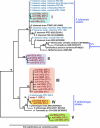Detection of diverse new Francisella-like bacteria in environmental samples
- PMID: 16151142
- PMCID: PMC1214603
- DOI: 10.1128/AEM.71.9.5494-5500.2005
Detection of diverse new Francisella-like bacteria in environmental samples
Abstract
Following detection of putative Francisella species in aerosol samples from Houston, Texas, we surveyed soil and water samples from the area for the agent of tularemia, Francisella tularensis, and related species. The initial survey used 16S rRNA gene primers to detect Francisella species and related organisms by PCR amplification of DNA extracts from environmental samples. This analysis indicated that sequences related to Francisella were present in one water and seven soil samples. This is the first report of the detection of Francisella-related species in soil samples by DNA-based methods. Cloning and sequencing of PCR products indicated the presence of a wide variety of Francisella-related species. Sequences from two soil samples were 99.9% similar to previously reported sequences from F. tularensis isolates and may represent new subspecies. Additional analyses with primer sets developed for detection and differentiation of F. tularensis subspecies support the finding of very close relatives to known F. tularensis strains in some samples. While the pathogenicity of these organisms is unknown, they have the potential to be detected in F. tularensis-specific assays. Similarly, a potential new subspecies of Francisella philomiragia was identified. The majority of sequences obtained, while more similar to those of Francisella than to any other genus, were phylogenetically distinct from known species and formed several new clades potentially representing new species or genera. The results of this study revise our understanding of the diversity and distribution of Francisella and have implications for tularemia epidemiology and our ability to detect bioterrorist activities.
Figures


References
-
- Anda, P., J. Segura del Pozo, J. M. Díaz Garcia, R. Escudero, F. J. Garcia Peña, M. C. López Velasco, R. E. Sellek, M. R. Jiménez Chillarón, L. P. Sanchez Serrano, and J. F. Martînez Navarro. 2001. Waterborne outbreak of tularemia associated with crayfish fishing. Emerg. Infect. Dis. 7:575-582. - PMC - PubMed
-
- Barton, K., and R. Obey. 9. October 2003. Officials following up on bacteria detection. http://www.ci.houston.tx.us/departme/health/bacteria%20detection.htm.Houston Department of Health and Human Services and Harris County Public Heath and Environmental Services News Release, Houston, Tex.
-
- Broekhuijsen, M., P. Larsson, A. Johansson, M. Byström, U. Eriksson, E. Larsson, R. G. Prior, A. Sjöstedt, R. W. Titball, and M. Forsman. 2003. Genome-wide DNA microarray analysis of Francisella tularensis strains demonstrates extensive genetic conservation within the species but identifies regions that are unique to the highly virulent F. tularensis subsp. tularensis. J. Clin. Microbiol. 41:2924-2931. - PMC - PubMed
Publication types
MeSH terms
Substances
Associated data
- Actions
- Actions
- Actions
- Actions
- Actions
- Actions
- Actions
- Actions
- Actions
- Actions
- Actions
- Actions
- Actions
- Actions
- Actions
- Actions
- Actions
- Actions
- Actions
- Actions
- Actions
- Actions
- Actions
- Actions
- Actions
- Actions
- Actions
- Actions
- Actions
- Actions
- Actions
- Actions
- Actions
- Actions
- Actions
- Actions
- Actions
- Actions
- Actions
- Actions
- Actions
- Actions
- Actions
- Actions
- Actions
- Actions
- Actions
- Actions
- Actions
- Actions
- Actions
- Actions
- Actions
- Actions
- Actions
- Actions
- Actions
- Actions
- Actions
- Actions
- Actions
- Actions
- Actions
- Actions
- Actions
- Actions
- Actions
- Actions
- Actions
- Actions
- Actions
- Actions
- Actions
- Actions
- Actions
- Actions
- Actions
- Actions
- Actions
- Actions
- Actions
- Actions
- Actions
- Actions
- Actions
- Actions
- Actions
- Actions
- Actions
- Actions
- Actions
- Actions
- Actions
- Actions
- Actions
- Actions
- Actions
- Actions
- Actions
- Actions
LinkOut - more resources
Full Text Sources
Other Literature Sources
Molecular Biology Databases

